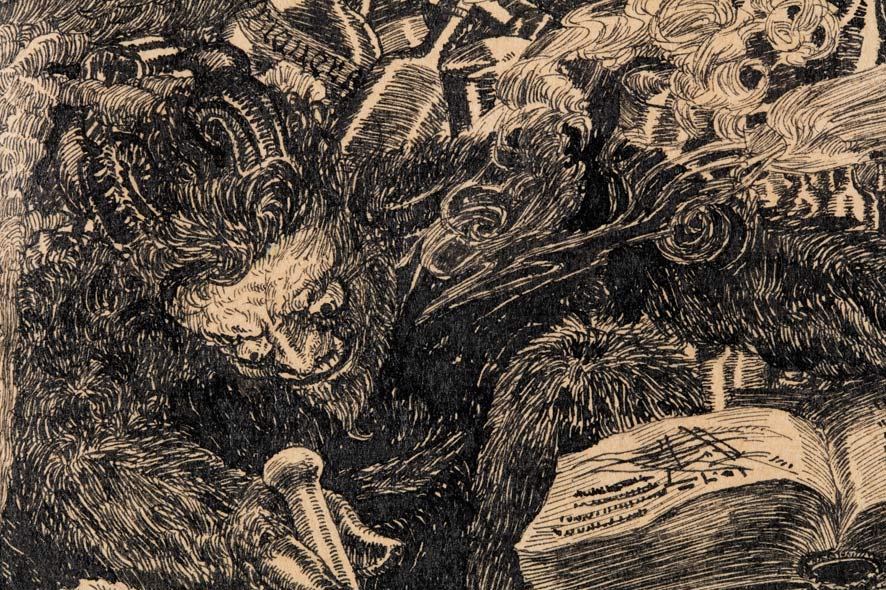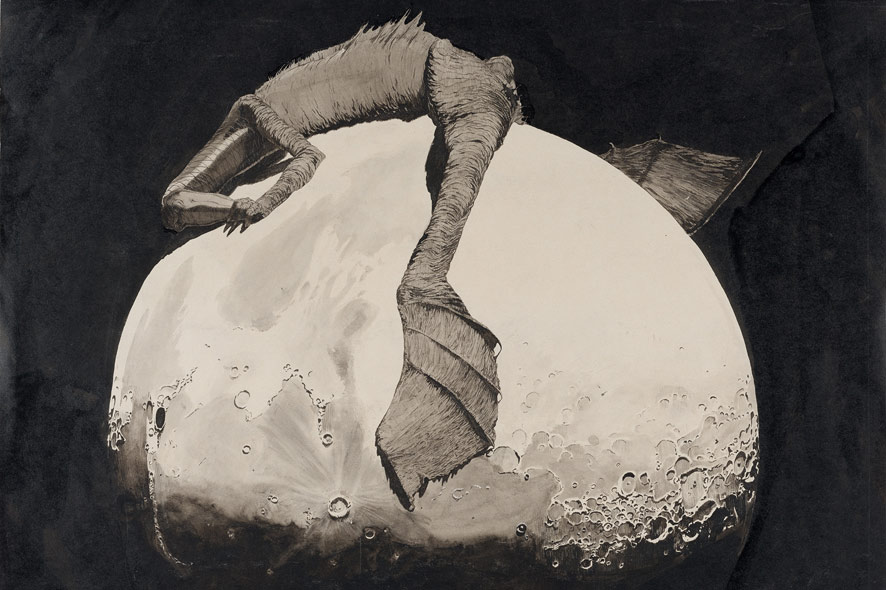Just prior to the end of the Klemens Brosch exhibition running in Landesgalerie Linz and NORDICO Stadtmuseum, curator Elisabeth Nowak-Thaller is presenting a selection of the artist’s graphics in Deep Space at the Ars Electronica Center. In a Deep Space LIVE Special on January 7, 2017 at 3 PM, she’ll go into detail about his extraordinary biography, shed light on Brosch’s relationship to Linz, and discuss his place in art history. Her talk will be lavishly illustrated by photographer Florian Voggeneder’s high-definition images of Brosch’s works.
You call Klemens Brosch a “wunderkind of drawing.” What makes him so special?
Dr.in Elisabeth Nowak-Thaller: At the age of 16, Klemens Brosch (1894-1926) not only exhibited exceptional talent for drawing; he was already a mature, up-and-coming artist who was making a name for himself. Suffering from severe illnesses during his approximately 16-year creative career (1910-1926), his estate included more than 1,000 drawings and watercolors, as well as several prints and a few oil paintings. If one makes an effort to characterize his oeuvre as a whole, then one is surprised by its diversity as well as the technical excellence of the representations.

Florian Voggeneder took high-resolution photos of Broschs drawings at NORDICO Stadtmuseum for the Deep Space 8K, Credit: Martin Hieslmair
Brosch’s hyperrealism, his unusual perspectives, the detailed close-ups and enlargements of particular areas of an image invariably come across as demonic and enigmatic. Plants and animals as well as human beings seem to be threatened by an eerie, invisible force. The landscape—one of his most important and extensive thematic clusters—seems petrified, deserted. Melancholy and memento mori are the artist’s constant companions. The virtuosity and technical brilliance of the rendering done with brush and pencil are taken to the outer limits of the magical. With points of view evoking psychological insight, Brosch portrays the enchantment and ephemerality of nature, the profoundly “hyperreal,” the uncanny, the symbolic.

Credit: Klemens Brosch / Weigelienblüten (1912), Grafische Sammlung_Landesgalerie Linz des OÖ. Landesmuseum
As curator of the NORDICO exhibition, you’ve taken an in-depth look at his works. What were the recurring motifs that struck you in going about this?
Dr.in Elisabeth Nowak-Thaller: Landscape, nature and natural scenes, depictions of war, a focus on technical subjects such as trains, ships, bridges and power plants, end-of-the-world scenarios and visions of death, and sci-fi-type representations.
Klemens Brosch was conscripted and served for several weeks on the front in World War I. What changes can be observed in his drawings during this period?
Dr.in Elisabeth Nowak-Thaller: When Brosch entered military service in 1913 as a one-year volunteer and was deployed in Galicia in 1914, his horror at the atrocities of war that he experienced and everyday life during wartime manifested themselves in the form of gripping, reproachful graphic documentations. Like a wounded soul, the line begins to accelerate, to vibrate; it becomes the only possible means of expressing a physical and mental inferno.

The Klemens Brosch exhibition at the NORDICO Stadtmuseum in Linz, Credit: Martin Hieslmair
Brosch, who suffered from respiratory illness since childhood, couldn’t withstand the strains of the fighting. After his 21-year-old brother Walter was killed in action in one of the first battles in 1914 in Pilica, Galicia, Klemens was classified as a malingerer, withdrawn from combat in Poland, shipped from one field hospital to the next, and finally discharged from the military.
An army doctor had already prescribed morphine as treatment for the artist’s pain in 1914, and Brosch became increasingly addicted to drugs (morphine and cocaine) after he reenrolled in the Academy of Fine Arts in 1915. Characteristic of the stylistic caesura that played out in 1920 were, in addition to a switch in technique to ink brush drawings, an exaggerated visual pathos—in many instances inspired by German literature—as well as nightmare scenarios and end-of-the-world visions triggered by the drugs he was on.

A detail of Klemens Broschs drawings, Credit: Florian Voggeneder
Please note: In Deep Space at the Ars Electronica Center on January 7th at 3 PM, Elisabeth Nowak-Thaller will show highly detailed images of Klemens Brosch’s drawings. The show in Landesgalerie Linz and NORDICO Stadtmuseum runs until January 15th.

Elisabeth Nowak-Thaller was born in 1960 in Linz, and lives in nearby Puchenau. She studied art history, journalism and communications at the University of Salzburg, where she earned her Ph.D. in 1985 with a dissertation on Klemens Brosch. Since 1986, she has been active as an art historian, exhibition producer, curator, art educator and provenance researcher at the Neue Galerie and LENTOS Art Museum in Linz. She is the deputy director and director of the painting & sculpture collection at the LENTOS; director of art at the Museums of the City of Linz; City of Linz equal rights coordinator; juror; art acquisition curator for the City of Linz, 2015-16; and, as of January 2017, interim director of the Museums of the City of Linz.
